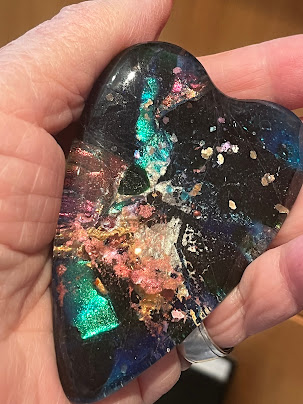What are coral reefs? Coral can be found in tropical ocean waters around the world. But how much do you know about reefs and the tiny animals—polyps—that build them? As I have been creating Fused Glass Coral pieces, I decided to learn a little about coral and why warming waters threaten the future of the reef ecosystem. National Geographic gave me this information.
Parks under the sea
Scientists often compare coral reefs to underwater
rainforests, yet unlike the leafy plant base of a forest, corals are animals. The soft polyps inside the hard parts of corals are naturally translucent and
get their famously vibrant color from algae living inside them.
People first noticed coral bleaching events in the 1980s. The problem intensified in 2016, when an El Niño weather pattern, which causes warmer waters in the Pacific Ocean, mixed with an already unseasonably warm ocean and killed off a third of the corals on the Great Barrier Reef. Since then, roughly half the corals on Australia’s famous reef have died in subsequent bleaching events, jeopardizing an underwater landscape 1,500 miles long.
The additional stress from warming waters is like “the proverbial nail in the coffin,” says Erinn Muller, the science director at the Elizabeth Moore International Center for Coral Reef Research and Restoration at the Mote Marine Laboratory in Sarasota, Florida.
To keep the wild ecosystem alive, Muller and her team are
harvesting samples of the corals that have survived the environmental stresses
naturally, breeding them by hand, and reattaching them to the reef. At any
given time, the center has 46,000 corals growing on underwater plastic lattices
in its nursery. So far, the center has regrown over 70,000 corals from five
different species on damaged reefs
Scientists around the world are looking for all kinds of
ways to protect and maybe even revive corals. One option is to create
more marine
protected areas—essentially national parks in the ocean. Scientists say
creating marine refuges, where fishing, mining, and recreating are off limits,
make the reefs healthier, and so more resilient.
In evolutionary history, corals date back 400 million years,
and with each global temperature change Earth has undergone, corals have
adapted—but never as quickly as they must today.
Without a mix of long-term cuts in emissions and short-term innovation, there’s a not-so-far-off future where coral reefs as we know them simply cease to exist, says Anne Cohen, a coral expert at the Woods Hole Oceanographic Institution in Massachusetts
“We know that because there have been six major coral reef
extinctions in the geologic past where they were basically wiped out. All those
have been associated with excessive heat and ocean acidification,” Cohen says.
“Coral reefs always come back, but it takes tens of thousands of years.”
Now, with climate change-driven temperatures rising at a
rate higher than corals have ever had to naturally adapt to, Cohen says, “we
don’t have that kind of time.”
We are living today in a world full of strife. Hatred is rife; death and suffering all too common. So, I was delighted that my research taught me this:
Amongst many initiatives throughout the world, Researchers are actually creating amazing ARTIFICIAL REEFS. Beginning in the laboratory, researchers evaluate various designs and materials, as well as surface composition, structural integrity, water flow, color and sand movement around coral structures.

The team who created the artificial reef in the above photo next builds scale models and tests them in a specialized flow tank that mimics currents and sedimentation processes. It then investigates the preferences of fish, crabs, corals and other animals that might inhabit the new reef. Each species has its own desires, and all must be catered to.
Once full-scale corals are deployed, scuba-diving biologists track how the artificial corals are colonized.
They’ve found that fish not only accept the 3D-printed corals; some actually prefer certain designs and colors over natural live corals! This knowledge is then used to design larger scale artificial reefs.
Israel recently joined several neighboring Arab states in a program to protect Red Sea coral reef ecosystems. The Red Sea Transnational Research Center will be located in Bern, Switzerland and will host researchers from Israel, Saudi Arabia, Egypt, Jordan, Eritrea, Sudan, Yemen and Djibouti.
Initiated by Bar-Ilan University professor Maoz Fine, the program will also include the University of Jordan marine science station in Aqaba and the King Abdullah University of Science and Technology in Saudi Arabia.
All of this is an exciting and promising venture in human, ecological and international relations.
I find myself thinking of this whenever I create my coral pieces ...these are created from glass powders, using a kind of pate de verre method, mixing the powder to a paste, packing into a mould, and eventually firing in a kiln for many hours. Or, I make "glass lace" which represents coral beautifully. They are all quite small, and are not as precious or important as real, or artificial corals of course, but it pleases me to create something two, or even three-dimensional rather than just rely on photos to see the beautiful corals that still exist on our planet. I sell to customers world-wide, who like to create glass items with them. Here are a few examples:

















